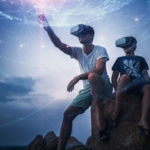Entrepreneurs: How to make the most of virtual reality?
Today, immersive storytelling is one of the main trends in innovation, marketing and the creation of customized experiences. Virtual reality increases the level of user engagement or enables better strategic decisions to be taken, among other features.

Beyond this much talked-about technology, what can it mean when applied to entrepreneurship or the creation of technology-based products or services? These are some possibilities:
- It offers a personalized immersive experience: one of the basic principles when developing a product or service is thinking like a user, putting oneself in their shoes, reading their mind. Virtual reality can offer the possibility of observing in real time the behavior and the decisions made by the user. Instead of asking users whether they prefer option A or B, the simulated environment enables them to make the selection spontaneously, which can result in a more honest action, less induced and therefore more valuable for assessing their behavior in terms of improving the product or service.
- It creates multisensory empathy: virtual reality experiences transcend the world of multimedia and offer stimuli for all the senses. The possibility of seeing, listening, touching and possibly trying creates a consolidated environment that offers a more comprehensive view of users and how and why they make their decisions. There is no longer the limitation of measuring a single user dimension, or having to measure them separately. In addition, the immersion of all the senses avoids distractions and increases the level of user engagement with respect to the proposed story.
- It eliminates narrative limits: one of the main marketing trends today is being able to tell a story, creating an entire story and a customized experience around the product. Virtual reality enables the creation of all kinds of stories, where imagination is the only limit, with the added value that the course of the story is decided by the users, even differently each time they access the experience.
- It reduces risks and costs : virtual reality makes it possible to simulate scenarios and situations that do not yet exist or are out of reach. This is a significant advantage, since it enables users to immerse themselves in far-away scenarios or in different types of situations without this representing any risk for their physical well-being. Virtual reality can also help reduce costs in terms of avoiding trips, assembly or production of physical prototypes, location adaptation or weather limitations.
- More accurate data in real time: All these possibilities result in virtual reality being able to provide more accurate and immediate information than other ways of testing a development. This data is turned into valuable information for making adjustments and strategic decisions for improving the product.
5 elements to take into account when creating a virtual reality experience
At the World News Media Congress, the expert in innovation and media business Matt MacKeey, a professor of immersive journalism at New York University, shared five key concepts for designing and developing a virtual reality experience.
Immersion: The experience must capture all of the user's attention. It must immerse users in a context where they can play the main character and feel empowered to the determine the course of the story.
Determine the subjective point of view of the main character: In virtual reality experiences users play the leading role, but they can do so from many points of view. They can be the characters on whom the main events of the environment fall, or they can be mere witnesses, or even determine what happens to others. Defining this point of view is essential for determining what information we want to extract from the user's experience.
Interaction: The greater the interaction, the more interesting the experience will be. The universe created should enable users to have a greater number of possible variables, so they don't feel limited when taking a course or some action with the elements presented.
Editing: Although users determine the course of the story, its design must be focused on ensuring some milestones and on drawing attention to some points of interest. The idea is to offer a free experience, but guided and focused on achieving goals that provide the information that the experience creator needs.
Experiment: Virtual realty is barely in the experimentation and development stage, which provides a huge potential for creating and experimenting. This is why it is very important to take risks when creating new immersive stories, since this is the best way to discover the many uses they can have in various areas of knowledge.